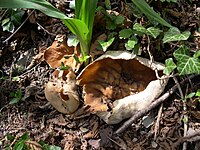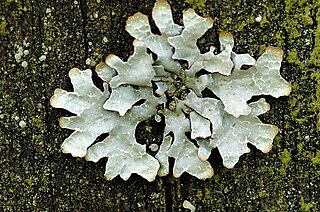
Parmelia is a genus of medium to large foliose lichens. The ends of the leaf-like lobes are often squarish-tipped. The upper surface is pale bluish-gray to light brown in direct sunlight, with a network web-like ridges and depressions. The lower surface is black and has rhizines anchoring it to the substrate.

Verpa is a genus of ascomycete fungi related to the morels. Resembling the latter genus in edibility and form, the common name early morels is popular. There are five species in the widespread genus.
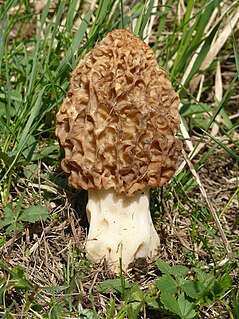
The Morchellaceae are a family of ascomycete fungi in the order Pezizales. According to a standard reference work, the family has contained at least 49 species distributed among 4 genera, but in 2012, 5 genera producing the sequestrate and hypogeous ascoma were added. The best-known members are the highly regarded and commercially picked true morels of the genus Morchella, the thimble morels of the genus Verpa, and a genus of cup-shaped fungi Disciotis. The remaining four genera produce the sequestrate fruit bodies.

The Pyronemataceae are a family of fungi in the order Pezizales. It is the largest family of the Pezizales, encompassing 75 genera and approximately 500 species. Recent phylogenetic analyses does not support the prior classifications of this family, and suggest that the family is not monophyletic as it is currently circumscribed.
Geomyces is a genus of filamentous fungi in the family Myxotrichaceae. Members of the genus are widespread in distribution, especially in northern temperate regions. Known to be psychrotolerant and associated with Arctic permafrost soils, they are equally prevalent in the air of domestic dwellings, and children's sandpits. Species of Geomyces have previously been placed in the genus Chrysosporium.
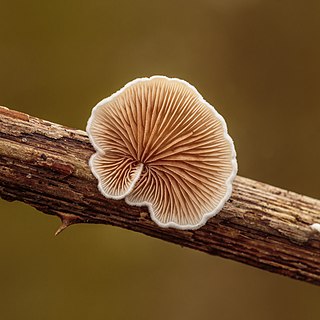
Crepidotus is a genus of fungi in the family Crepidotaceae. Species of Crepidotus all have small, convex to fan-shaped sessile caps and grow on wood or plant debris. The genus has been studied extensively, and monographs of the North American, European and Neotropical species have been published.

Sphaerobolus is a genus of fungi in the family Geastraceae. Commonly known as the "shotgun fungus" or "cannonball fungus", species discharge their spores with explosive force. Discharged spore sacs are sticky and have a tendency to strongly adhere to whatever surface they encounter, making them a nuisance to homeowners, pressure washing contractors, landscape mulch producers and insurance companies.

Dothideales are an order of bitunicate fungi consisting mainly of saprobic or plant parasitic species.
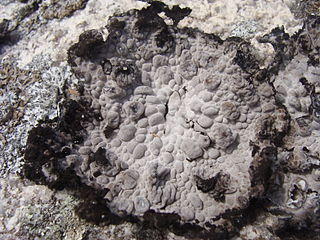
Lasallia is a genus of lichenized fungi in the family Umbilicariaceae. The genus contains 12 species with a widespread, but predominantly temperate distribution. Phylogenetic analysis of internal transcribed spacer DNA has shown that the genus is monophyletic.
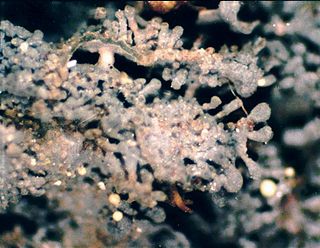
An isidium is a vegetative reproductive structure present in some lichens. Isidia are outgrowths of the thallus surface, and are corticated, usually with a columnar structure, and consisting of both fungal hyphae and algal cells. They are fragile structures and may break off and be distributed by wind, animals, and splashing raindrops. In terms of structure, isidia may be described as warty, cylindrical, clavate (club-shaped), scale-like, coralloid (coral-shaped), simple, or branched.

The Orbiliaceae are a family of saprobic sac fungi in the order Orbiliales. The family, first described by John Axel Nannfeldt in 1932, contains 288 species in 12 genera. Members of this family have a widespread distribution, but are more prevalent in temperate regions. Some species in the Orbiliaceae are carnivorous fungi, and have evolved a number of specialized mechanisms to trap nematodes.

The Inocybaceae are a family of fungi in the order Agaricales. Members of this family have a widespread distribution in tropical and temperate areas.

Urnula is a genus of cup fungi in the family Sarcosomataceae, circumscribed by Elias Magnus Fries in 1849. The genus contains several species found in Asia, Europe, Greenland, and North America. Sarcosomataceae fungi produce dark-colored, shallow to deep funnel-shaped fruitbodies with or without a stipe, growing in spring. The type species of the genus is Urnula craterium, commonly known as the devil's urn or the gray urn. Urnula species can grow as saprobes or parasites having an anamorphic state. The anamorphic form of U. craterium causes Strumella canker, on oak trees.

Caloscypha is a fungal genus in the family Caloscyphaceae. A monotypic genus, it contains the single species Caloscypha fulgens, commonly known as the spring orange peel fungus, the golden cup, or the dazzling cup. It is a cup fungus, typically up to 4 centimetres (1.6 in) in diameter, with a bright to pale orange interior and orange; specimens that are old or bruised often have an olive-green discoloration, especially around the edges. In North America, it is usually found on the ground in forest litter near conifers. Fruiting occurs in early spring following snow melt. The asexual (imperfect), or conidial stage of C. fulgens is the plant pathogenic species Geniculodendron pyriforme, known to infect dormant seeds of the Sitka spruce.
The Coniochaetales are an order of fungi within the class Sordariomycetes. This order is monotypic and contains a single family, the Coniochaetaceae, historically placed in the order Sordariales. However, this taxonomic placement has been challenged by other authorities, and the Coniochaetales was proposed to include the family Coniochaetaceae. Species in this family are characterized by having germ-slits in the ascospores, a morphological feature that distinguishes them from species in the Sordariaceae. Phylogenetic research in 2006 revealed that four genera in the family Coniochaetaceae, Coniochaeta, Coniochaetidium, Ephemeroascus, and Poroconiochaeta, were not monophyletic, and were all made synonymous with Coniochaeta.

Astraeus is a genus of fungi in the family Diplocystaceae. The genus, which has a cosmopolitan distribution, contains nine species of earthstar mushrooms. They are distinguished by the outer layer of flesh (exoperidium) that at maturity splits open in a star-shape manner to reveal a round spore sac. Additionally, they have a strongly hygroscopic character—the rays will open when moist, but when hot and dry will close to protect the spore sac. Species of Astraeus grow on the ground in ectomycorrhizal associations with trees and shrubs.
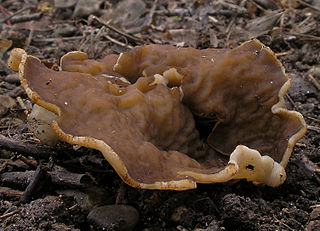
Disciotis venosa, commonly known as the bleach cup, veiny cup fungus, or the cup morel is a species of fungus in the family Morchellaceae. Fruiting in April and May, they are often difficult to locate because of their nondescript brown color. Found in North America and Europe, they appear to favor banks and slopes and sheltered sites. Although D. venosa is considered edible, it may resemble several other species of brown cup fungi of unknown edibility.
Leucosporidiella is a genus of fungi found in the family Leucosporidiaceae. It contains 3 species.
Leucosporidium is a genus of fungi found in the family Leucosporidiaceae. It contains 5 species.
Mastigobasidium is a monotypic genus of fungi found in the family Leucosporidiaceae. It contains the sole species Mastigobasidium intermedium..
